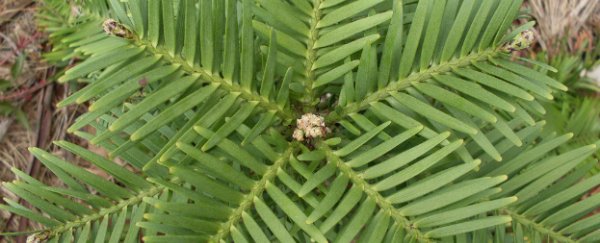Tiny soil fungi could be the key to helping to save a living fossil, new research by the Hawkesbury Institute for the Environment at the University of Western Sydney in Australia has found.
The Wollemi pine (Wollemia nobilis) is one of the rarest and oldest trees in the world. In fact, just 20 years ago it was presumed to have been long extinct, as scientists had only ever seen it in fossils.
But in 1994, a population of fewer than 100 of the trees were discovered alive in a forest just outside Sydney, Australia. Fascinatingly, the species is more than 65 million years old – that means these trees were around when the dinosaurs were roaming the Earth, and have somehow survived until today, hence their nickname of being "living fossils".
Although the trees are now common in nurseries around the country, the remaining wild trees are under threat from a soil pathogen called Phytophthora cinnamomi, which causes root rot. Scientists are urgently trying to find new ways to fight this root-rot pathogen, as well as identify new locations to set up future populations in order to prevent the ancient trees from becoming extinct. And it turns out that soil could be the key to both.
"They're an iconic species and there are fewer than 100 left in the wild," says Jessica Mowle, a PhD student at the Hawkesbury Institute, who is leading a project on how the Wollemi pines affect the soil environment they're planted in. "We're extremely interested in keeping them alive."
Mowle's research suggests that the soil environment the trees are planted in could play a big role in the species' survival, and might even help to fight off root rot. It also suggests that the trees can actually attract beneficial bacteria and fungi to their root in order to create a good soil environment - which might help explain why they've been so good at surviving for 65 million years.
Although it sounds strange that bacteria and fungi in soil can affect a tree, a growing body of evidence suggests that the balance of these soil environments could help to keeping pathogens away and a range of plants to grow. It's a similar situation to the gut bacteria environment in our own stomachs, which are necessary to keep us healthy.
"Part of my previous research showed that when Wollemi seedlings are planted in soil under their own parent trees, they gather different fungal communities and grow better than when they're planted in soil further away," says Mowle.
"You'd expect that the trees would do more poorly underneath their parents because of a build-up of natural enemies around the adult trees, but these results suggest there's something beneficial around their adults," she adds. "We believe the adults are gathering a beneficial microbial community under them."
The research team at the Hawkesbury Institute for the Environment is now working with the Australian Office of Environment and Heritage, the Royal Botanic Gardens and the University of Melbourne to try to find the ideal location for a new wild population of 190 Wollemi pines.
"I want to understand if there's a particular soil environment where Wollemi do best, and whether they can gather a specific microbial community to them in these new locations," says Mowle.
The ultimate goal now is to identify which environments and also which soil microbes can help the trees fight off P. cinnamomi.
And if scientists can work out the right soil for the trees to succeed, we'll hopefully be a step closer to being able to keep these unique trees alive for at least another couple of centuries.
After all, who doesn't want the next generation to be able to walk amongst living fossils?
The Hawkesbury Institute for the Environment is interested in hearing from the world's future scientists. Scholarship opportunities are available until late October - make contact with a researcher today.
